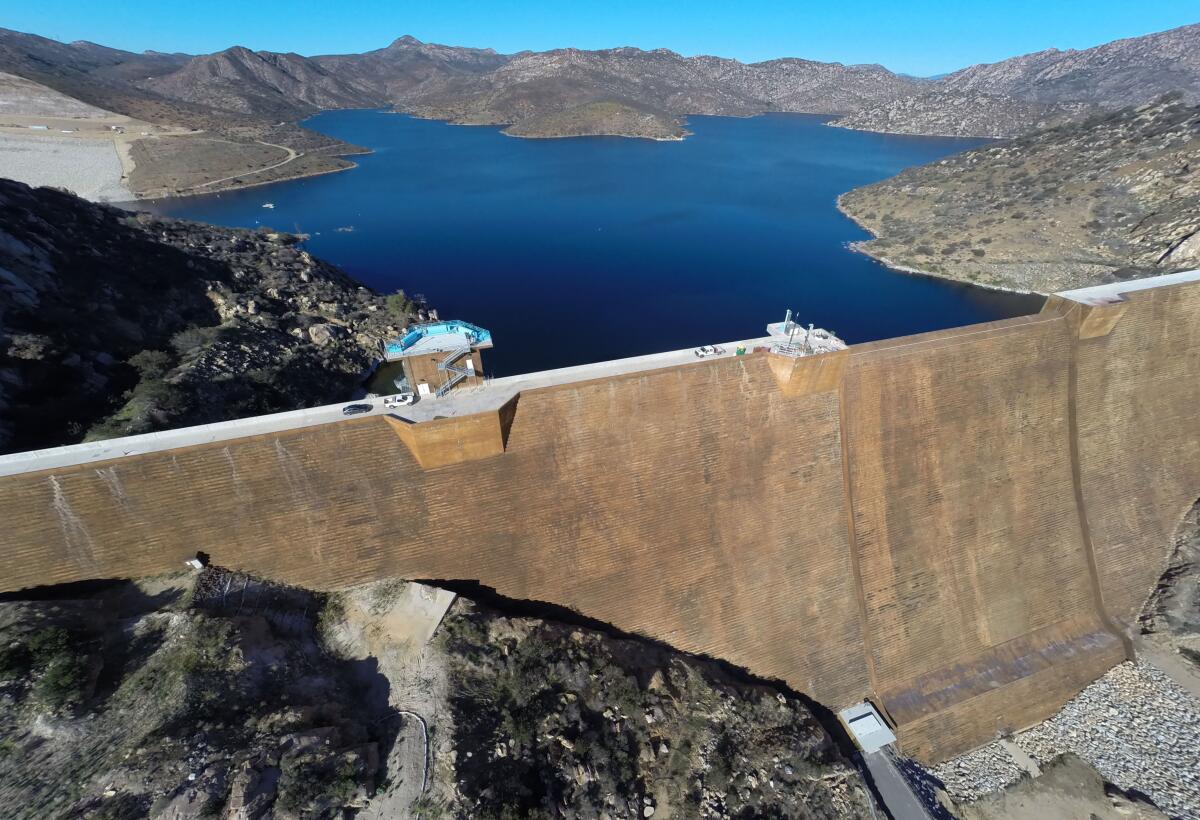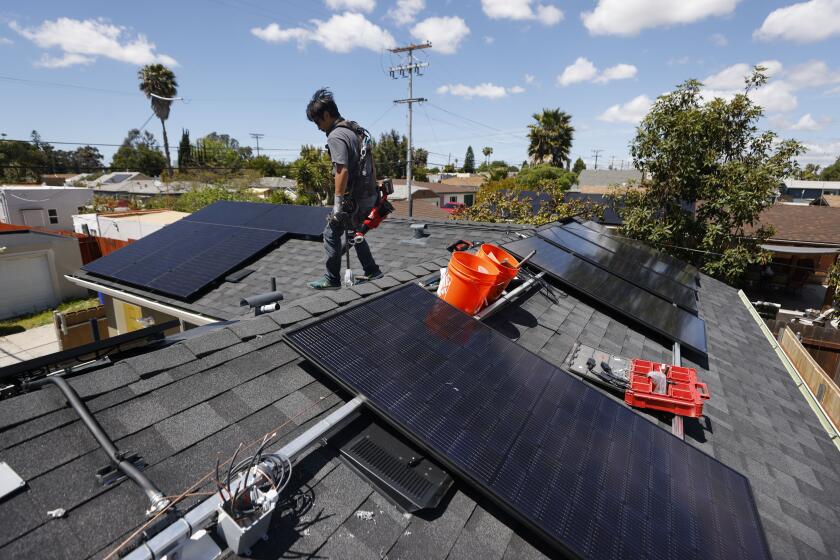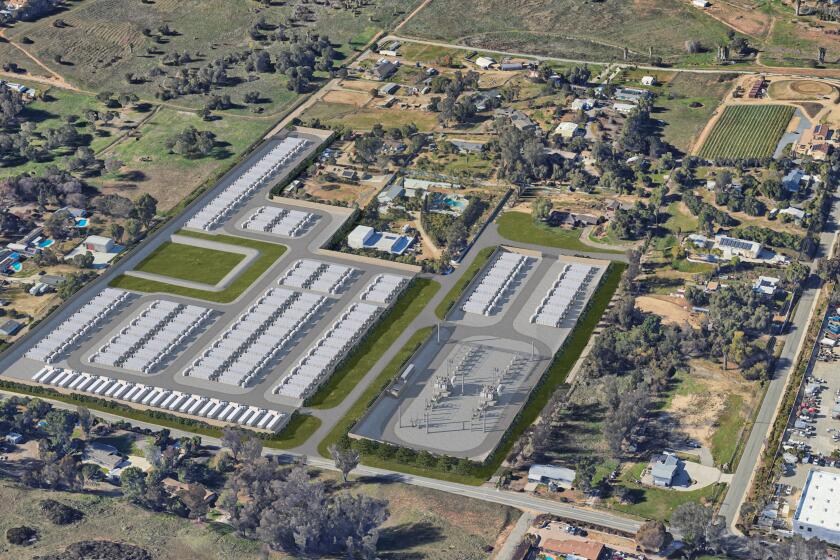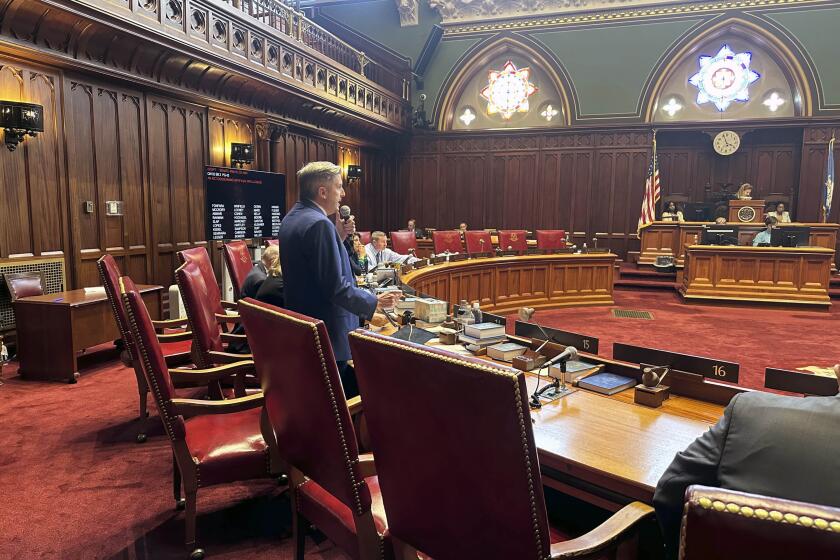First steps taken to make pumped hydro energy storage project at San Vicente Reservoir a reality

$18 million from state budget earmarked for joint effort between the city and SD County Water Authority
With an $18 million boost from the state, a major energy storage project using hydroelectric power is taking shape at the San Vicente Reservoir, nestled in the Cuyamaca Mountains near Lakeside.
The long talked about San Vicente Energy Storage Facility — proposed by the city of San Diego and the San Diego County Water Authority — received the funding earlier this month when Gov. Gavin Newsom signed the state budget. The $18 million will be spent to tackle some of the preliminary work needed to make the “pumped hydro” project a reality, such as initial design, environmental reviews and federal licensing.
For the record:
8:56 a.m. July 27, 2021The story has been updated to point out that the San Vicente project would generate more than 12 times the electricity of the Lake Hodges facility when at full capacity.
“We believe the project is a critical component to meeting the state’s needs for integrating renewables” into the power grid, said Gary Bousquet, deputy director of engineering at the County Water Authority.
Next month, the city and the Water Authority expect to issue requests for proposals and eventually line up a private partner to take on what’s estimated to be a $1.5 billion construction and development project.
Pumped hydro projects have been part of the nation’s energy grid for more than 100 years. The concept is pretty basic: Using turbines, water is pumped from one reservoir up to another at a higher elevation. The water is then released and the ensuing rush of water generates electricity.
Using pumped hydro projects as a means of storing energy has taken on a greater focus as California moves forward on its goal to derive 100 percent of its electricity by 2045 — if not sooner — from sources of power that do not release greenhouse gases into the atmosphere.
California’s grid has integrated more renewable energy sources, but solar and wind are intermittent — that is, solar power is produced only when the sun shines and wind power flags when the breezes don’t blow. Other sources are needed to fill in the gaps. Natural gas can do the job, but it is a fossil fuel.
Energy storage, such as batteries, has increasingly become a potential solution. But so has pumped hydroelectric storage, and that’s what the city and county are looking for the San Vicente Energy Storage Facility to do — providing an estimated 500 megawatts of electricity when the grid needs it.
For perspective, when the San Onofre Nuclear Generating Station was up and running, it accounted for a little over 2,000 megawatts of power.
In addition, while the duration of battery storage usually is four hours, the San Vicente Energy Storage Facility would provide electricity for a longer duration — for eight hours and 4,000 megawatt-hours per day. The project is expected to provide enough energy for about 135,000 households.
The already existing San Vicente Reservoir that holds up to 247,000 acre-feet of water would act as the lower reservoir, and an upper reservoir estimated to hold about 8,000 acre-feet of water would be built at a higher elevation into the hillside. A tunnel system and an underground powerhouse containing four reversible pump turbines would connect the two reservoirs.
When there’s plenty of solar and wind getting generated during the day, “you can pump water up the hill,” Bousquet said. “And then at the end of the day when everybody comes home from work and air conditioning is turned on and the solar is coming offline, you could energize this facility, flow water downhill and meet the needs (of the grid) during that time.”
Electricity from the project can be fed into a nearby San Diego Gas & Electric substation.
David Victor, a UC San Diego professor who co-directs the university’s Deep Decarbonization Initiative, has been a strategic consultant to the city of San Diego on the San Vicente Energy Storage Facility. Victor says pumped hydro projects should be seen as a “quiver of arrows the state needs to have when you put a lot of renewables” on the grid.
“This is to some degree uncharted territory,” Victor said. “There’s no large grid that ever made such a transformation so quickly as what’s going on in California ... There’s a lot of that that still need to be worked out with regard to the grid of the the future for California, but one of the things that all the models point to is that there’s this big increase in the need for storage of different types.”
The San Vicente project will be a closed-loop system that will hold water that is not reliant on runoff so it should be insulated from year-to-year fluctuations that can hamper hydropower production. The Water Authority said the project will not interfere with existing water supplies, water quality, fisheries or recreational activities at San Vicente.
“Over the last 20 years, the Water Authority and the city have built the emergency storage project, which raised San Vicente Dam, and behind the dam we keep a supply of water for emergencies,” Bousquet said.
After the request for proposals go out in the coming weeks, Bousquet said potential partners will be interviewed. Eventually, the San Diego City Council and the Water Authority Board will approve the entity selected to proceed with the environmental and licensing work. The project is scheduled to be completed in 2030.
“Once we have the project development agreement, the developer puts up all the money to advance the project,” Bousquet said. “They get financing and they put all that money upfront and then they collect their money on the backend once the facility is in operation. So one of the key benefits is that no taxpayer dollars are needed to develop the project” beyond the $18 million coming from the state budget.
The $18 million figure includes California Environmental Quality Act and federal government’s National Environmental Policy Act reviews, as well as licensing from the Federal Energy Regulatory Commission.
There’s already a pumped hydro storage facility in San Diego. Lake Hodges has a two-turbine pumphouse that sends water up 770 feet from the city-owned Hodges Reservoir to the the Water Authority’s Olivenhain Reservoir more than a mile away, generating some 40 megawatts of power on demand. At 500 megawatts, the proposed San Vicente project would generate more than 12 times the electricity of the Lake Hodges facility when at full capacity.
According to the California Energy Commission, four pumped storage facilities are used to help California’s grid during times of peak energy demand: Castaic Lake in Los Angeles County, with 1,331 megawatts of nameplate capacity (generation under ideal conditions); Helms in Fresno County, with 1,212 megawatts; Eastwood in Fresno County at 200 megawatts; and Lake Hodges.
Get U-T Business in your inbox on Mondays
Get ready for your week with the week’s top business stories from San Diego and California, in your inbox Monday mornings.
You may occasionally receive promotional content from the San Diego Union-Tribune.











